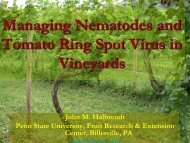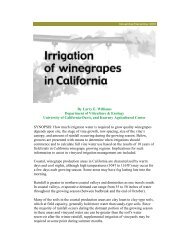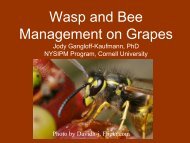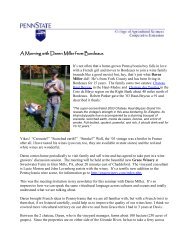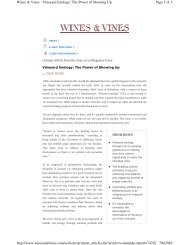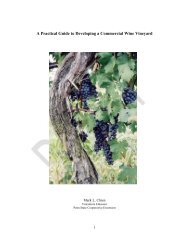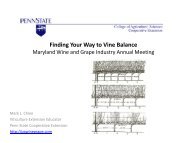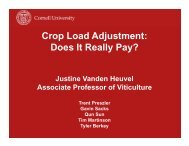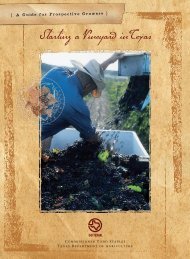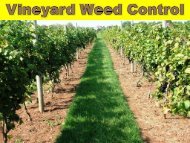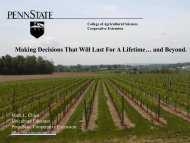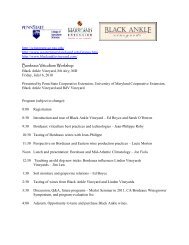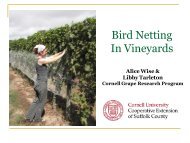Pinot Noir in Eastern N. America - PA Wine Grape Growers Network
Pinot Noir in Eastern N. America - PA Wine Grape Growers Network
Pinot Noir in Eastern N. America - PA Wine Grape Growers Network
You also want an ePaper? Increase the reach of your titles
YUMPU automatically turns print PDFs into web optimized ePapers that Google loves.
of producers together aga<strong>in</strong> and discuss the<br />
state of the grape. So with the help of Gene<br />
Pierce and Steve DiFrancesco at Glenora,<br />
about 25 producers and extension educators<br />
from 4 states and Ontario (photo left)<br />
gathered recently to taste and talk about<br />
regional <strong>P<strong>in</strong>ot</strong> <strong>Noir</strong>.<br />
Fundamentally, one has to wonder if great<br />
<strong>P<strong>in</strong>ot</strong> is possible <strong>in</strong> any place that is not<br />
entirely focused on master<strong>in</strong>g it. There are<br />
only a few other grape varieties, like<br />
Nebbiolo and Sangiovese, that demand full<br />
and undivided attention <strong>in</strong> order to excel, and even <strong>in</strong> the case of the two Italian varieties, it may<br />
not be possible to make a great w<strong>in</strong>e outside of their home regions. But PN has demonstrated<br />
some adaptability to other areas, so maybe there is some hope. Currently, there are a few<br />
w<strong>in</strong>eries <strong>in</strong> Ontario, and one <strong>in</strong> the F<strong>in</strong>ger Lakes, that have planted the <strong>P<strong>in</strong>ot</strong> flag and, like<br />
Oregon, declared “<strong>P<strong>in</strong>ot</strong> <strong>Noir</strong> or Bust.” It might not be a surprise that they are mak<strong>in</strong>g some of<br />
the best examples of the variety. Oregon was lucky - from the day David Lett arrived <strong>in</strong> Dundee,<br />
it was all about <strong>P<strong>in</strong>ot</strong>. When a lot of smart people put their hearts and m<strong>in</strong>ds to a s<strong>in</strong>gular task,<br />
and the terroir is the least bit accommodat<strong>in</strong>g, the possibilities are encourag<strong>in</strong>g and the results are<br />
often thrill<strong>in</strong>g. I th<strong>in</strong>k that if there is to be a viable <strong>P<strong>in</strong>ot</strong> community <strong>in</strong> the East, then some of<br />
this attitude and approach must be adopted. I’m pretty sure that you cannot make 25 w<strong>in</strong>es and<br />
make great <strong>P<strong>in</strong>ot</strong>.<br />
Depend<strong>in</strong>g on one’s view, we had the either the good or bad fortune to taste w<strong>in</strong>es for two<br />
entirely different v<strong>in</strong>tages, 2011 and then 2010. The results were both expected and reveal<strong>in</strong>g –<br />
and, <strong>in</strong> my memory, not unlike my experiences at Steamboat. To sum it up, w<strong>in</strong>e quality was all<br />
over the map. As I cont<strong>in</strong>ue to work <strong>in</strong> this region, I am conv<strong>in</strong>ced that proximity to the coast<br />
may be, over time, the key to success, i.e. the more exposed a v<strong>in</strong>eyard is to the bad weather that<br />
comes off the Atlantic Ocean, the harder it is to make consistently f<strong>in</strong>e w<strong>in</strong>es, no matter how<br />
strong the terroir or determ<strong>in</strong>ed the effort. In this tast<strong>in</strong>g, the w<strong>in</strong>es from Ontario and W NY<br />
appear to give some validity to this notion. By the way, as much talk as there is about the f<strong>in</strong>e<br />
<strong>P<strong>in</strong>ot</strong>s from the bench below the escarpment on the Niagara Pen<strong>in</strong>sula, Bob Green brought<br />
surpris<strong>in</strong>gly pleas<strong>in</strong>g <strong>P<strong>in</strong>ot</strong>s grown on top of the escarpment <strong>in</strong> Western NY from Freedom and<br />
Liberty v<strong>in</strong>eyards, and this is an excit<strong>in</strong>g new development <strong>in</strong> New York. Given these climatic<br />
conditions w<strong>in</strong>e growers simply have to try harder <strong>in</strong> the v<strong>in</strong>eyard and cellar. It means more<br />
rigorous viticulture <strong>in</strong> preparation for poor conditions after veraison because so much of what<br />
delivers quality <strong>in</strong> the end must be <strong>in</strong>vested up front, early <strong>in</strong> the grow<strong>in</strong>g season – probably<br />
mostly <strong>in</strong> the areas of achiev<strong>in</strong>g v<strong>in</strong>e balance, disease and <strong>in</strong>sect management, and particularly<br />
fruit rot protection. There was agreement that 36” (1000mm) of ra<strong>in</strong>, which is the amount that<br />
fell on parts of SE <strong>PA</strong>, NJ and MD dur<strong>in</strong>g the harvest season is a game-ender for most grapes but<br />
especially <strong>P<strong>in</strong>ot</strong>, but the 10” or so that fell on the F<strong>in</strong>ger Lakes, while it would scare the pants off<br />
of any California w<strong>in</strong>e maker, is considered a manageable amount <strong>in</strong> the F<strong>in</strong>ger Lakes. The<br />
w<strong>in</strong>es we tasted (or didn’t taste because they did not exist) reflected these amounts and<br />
conditions, and the skill necessary to cope with them. Jean-Pierre Colas from 13 th Street W<strong>in</strong>ery



